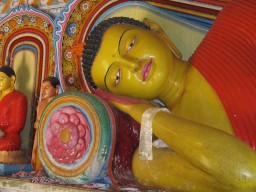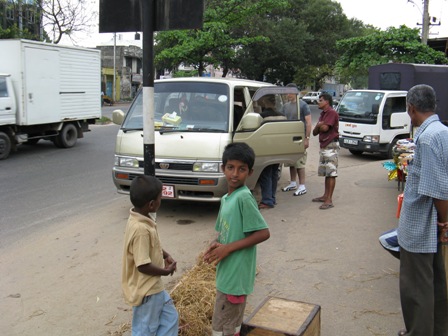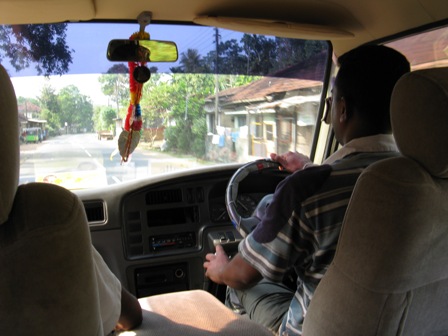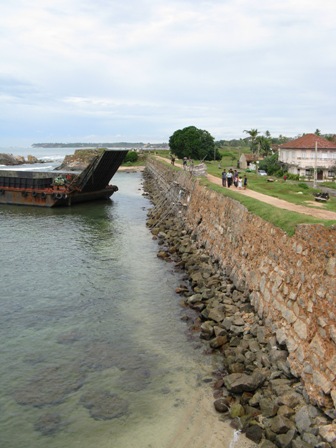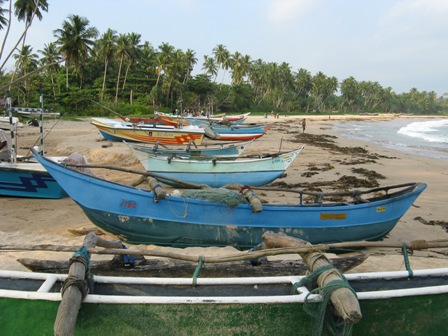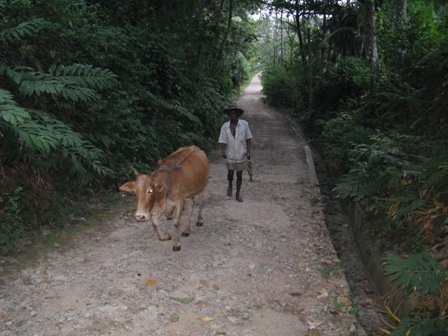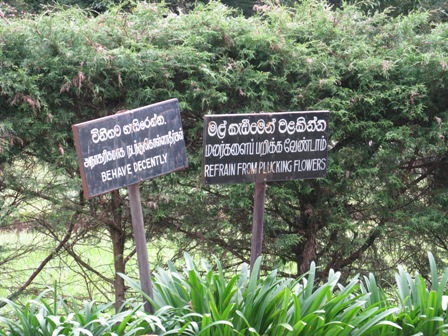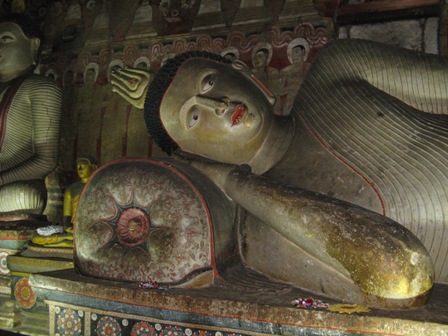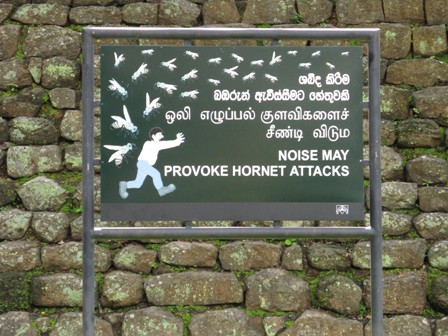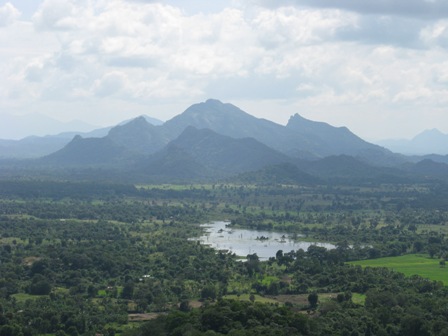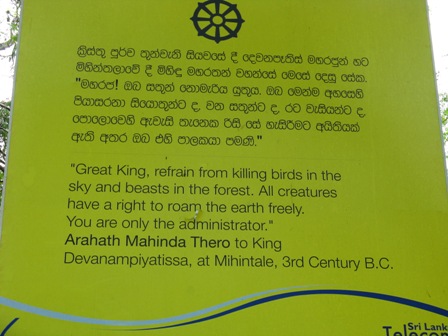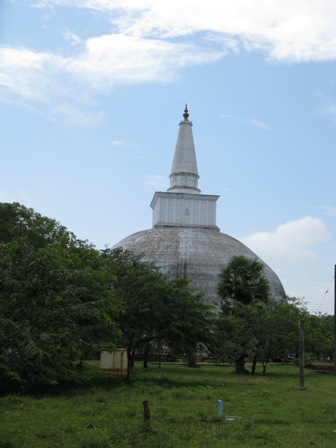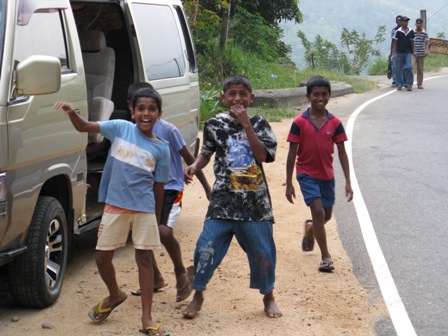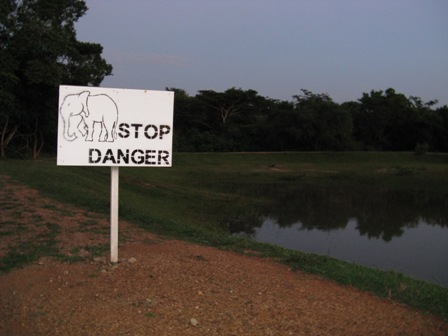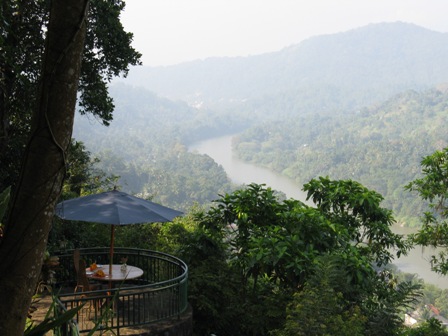Sri Lanka continues to seduce in surprising ways.
Chamindah stops the van. He turns around, smiles at me and points to a large tortoise trying to cross the road. I climb out, pick it up and place it gently near a tree in the direction it was travelling. Chamindah clasps his hands together giving thanks to Buddha and we set off towards the rock monastery fortress of Sigiriya.
I decide that I like our local guide and driver Chamindah despite his hapless nature and his lackadaisical attitude about punctuality. He’s a faithful Buddhist, has a grin as wide as the rear end of a water buffalo and stops for all animals no matter how small they are. He dodges kittens and puppies with sacred alacrity.
When the van broke down days before, the first of many times, he turned round smiled and said “One minute.” Hours later the van was repaired. According to Chamindah time, one minute means two hours. Two hours means days. Luckily he never says “In a couple of days.” No doubt I’d still be in Sri Lanka, plodding along like my friend the tortoise, safe from death by road kill but never punctual.
But I don’t mind. All mishaps provide opportunities for chatting with friendly local mechanics who can apparently fix a broken radiator hose with a rubber band. A disconnected fly-wheel is repaired with a piece of scrap metal and twisted wire. Smiles all around, endless cups of tea, maybe a beer if it’s late in the afternoon, it’s so easy to while away the hours. I’m riding on serendipity time; recalling this island nation’s previous moniker, Serendib and I’m ready for unexpected pleasures no matter the form they take. Sri Lanka has had many names. For me they all mean the same, Halfway to Paradise on the Road to Nirvana.
Breaking the journey with a stay in Galle at the exquisite Galle Fort Hotel, hanging round the hotel pool interspersed with relaxing walks within the old city’s walled centre or visiting nearby beaches, the impact of tourism is never far away. Southern Sri Lanka is the favoured winter respite for many visiting European tourists. Galle has mostly resisted being turned into a beach destination but beachside towns between Colombo and Galle have thoroughly embraced tourism. Large hotels continue to sprout up like mushrooms in compost while not all developments are built in best taste.
East of Galle, development is less rampant as a few beach towns between Galle and the Yala National Park’s western border haven’t all been swamped by tourism money making schemes.
We find some respite and crowd relief in tiny Talalla while staying in a pseudo-holistic beach resort. I say pseudo because the whole area is holistic. The beach is entirely devoid of large-scale development, a relief to ears and eyes. An evening walk in nearby Gandara provides a gift; a glimpse into Sri Lanka before war and political corruption wrecked a lot of lives. Even the 2004 tsunami’s after effects seem less dire here.
Beach combing attractions aside, Sri Lanka’s interior is historically, ecologically and culturally more interesting. We stop for a day at Pinnawalla elephant orphanage, checking out its reputation for admirable elephant care. Though it’s something of a tourist show, particularly when some of the orphanage’s elephants walk to the river for a daily bath, the whole place has an atmosphere of openness. Elephants roam freely among visitors though a couple of mature males in musth are chained to posts and visitors are warned away. Greater emphasis on education about these endangered animals would be beneficial but as an orphanage accessible to the general public, it’s not a bad place in which to begin an understanding of Asian elephants and their plight for safe habitats in overcrowded countries.
Kandy is a requisite stop. Sri Lanka’s holy city is the entry point to the central highlands and key to understanding the importance of Buddhism to the national identity. The Sri Dalada Magiwala (Sacred Tooth Temple) is the country’s most important religious shrine, an obligatory pilgrimage stop for any visit to Sri Lanka. Kandy is also the country’s cultural centre. Music and dance performances abound, some aimed at tourists, more at local celebrants. The central Kandy market is one of the country’s best. As the commercial focus for this small city’s permanent population, it’s the town’s heart and the most important nexus in which to gauge how Kandy town differs greatly from Colombo city.
Tea plantations cover much of Sri Lanka’s interior. The town of Nuwara Eliya (meaning ‘City of Light’ or ‘City of the Plain’) is near the ecologically significant Horton Plains National Park and is more or less tea central. Great paddocks of tea plants (camellia sinensis) surround the whole area. The Victoria Park in the centre of town is worth visiting, if only to read signs indicating what not to do, wear, speak or behave. Prissy Victorian English mores took root in the highlands of Sri Lanka while remnant traditions remain. Much of Nuwara Eliya’s architecture is Anglo-Indian, a bit of the Raj in central Sri Lanka.
From Kandy, we drive haphazardly into the interior, our destination the Cultural Triangle. Here Sri Lanka’s kingdoms held sway over the whole of the island centuries ago. From the capital at Anuradhapura a great dynasty ruled. While other south Asian historic ruins: Angkor Wat, Ayutthaya and Borobudur are known to most travellers, Sri Lanka’s are not, which is a pity as they’re packed with architectural treasures. Since the fighting between the Tamil Tigers and the National Army ceased in 2010, the going is easier though occasional road blocks remain in place. The area around the Cultural Triangle was formerly the border zone caught between opposing sides. Now it’s well within control of the Sri Lankan Government. No matter your political views, the local people have suffered due to a lack of travellers from abroad and recovery is slow.
It’s very quiet in this region, few visitors are about. Police roadblocks check passing vehicles but we’re never bothered. As soon as they see a couple of foreigners in the clapped out van they wave us on with a smile. The Sri Lankan economy depends heavily on tourism. Combined disasters: the tsunami of 2004 and the internecine war fought for over thirty years have proved knock-out blows to international tourism. Two paramount concerns prevail: unemployment and lack of income. We are welcomed everywhere we go with open arms; clearly our visit is a boon for local businesses.
The road north from Kandy leads first to the evocatively mysterious cave temples at Dambulla. Its frescos and statues depicting the Buddha in numerous poses are marvels of painterly consistency and stony constancy. The Buddha’s smiles are so subtly different that the artisans crafting his serene visage must have had a master template from which to work. A few enormous statues barely fit into their gallery like caves, adapted to the natural contours of the sloping walls.
Cool interiors and dimly lit spaces contrast dramatically with the heat and hard light outside. We’ve climbed hundreds of steps to reach the plateau where five caves extend in a line along a natural fold in the mountain. The statues were carved during the reign of King Valagamba (1st century BCE). Over 150 Buddha images may be seen here. I lose count after 80.
Atop the terraced ledge from which the caves overlook surrounding countryside, I stop to gaze at monsoon drenched paddy fields and palm groves. Three silent macaque monkeys sitting lotus like in a tree branch directly above my head also take in the view. For a moment, I imagine they are calmed by the Buddha’s presence as me.
Though Sri Lanka is an island roughly the size of Tasmania, they have in common a perception of immensity. My eyes wander towards the central highlands, its highest elevations marking 2,000 plus metres. The sharp peaks, densely forested slopes and tea plantations make me wonder if I’m looking at a continent. It seems that big.
The volcanic outcrop of Sigiriya thrusts upwards. From the heights of Dambulla, the geological wonder that is Sigiriya stands alone. On a vast jungle plain criss-crossed by elephant tracks and dotted with small villages tucked away in swards of green, Sigiriya looks like a fantasy fortress. How the monks and their assistants built anything atop the sheer walled promontory is a wonder in itself.
The surrounding water gardens add to the overall impression that the whole complex is something of a miracle in its inception, much less its completion. Moats encompass the gardens, signs warning visitors not to get too close for fear of crocodiles and water monitors keep even the foolhardy from indulging in a cooling dip. Snakes hide in the rushes searching for frogs. Langurs and macaques loop from one tree to the next. The scene is Eden-esque, outwardly tamed but secretly wild. Making our way to the famous boulder gardens, ancient watercourses marking the path, a hornet’s nest is the only danger we encounter. The sign indicating the presence of the little beasties is one of the few modern touches, albeit a silly one. Evidently the best thing to do when encountering a swarm of angry hornets is to wave one’s arms furiously about whilst sprinting like an Olympian in pursuit of a gold medal.
Sigiriya’s history reveals much. Once believed to have been the fortress sanctuary of a 4th century CE king, archaeologists now consider that by the 3rd century BCE, Sigiriya was an important monastery devoted to Mahayana-Theravada Buddhism which also supported a thriving city. The whole monument was declared a UNESCO World Heritage Site in 1982.
Climbing to the top of Sigiriya is best done slowly. After a couple hours wandering around the ancient city’s foundations, walls and gardens, we’re at the base of the fortress itself. Two huge carved lion’s paws, all that’s left of a gigantic leonine statue that guarded the entrance to the final ascent, grasp the bottom steps. It’s like passing between two stupendous costume party shoes. The Mirror Wall we pass on the way to the summit forms a long corridor that protects dizzy climbers from tumbling down the sheer rock face. A thousand years of graffiti adorns its glazed surface. Linguists have been studying versions of ‘I was here with Chamindah’ since Sigiriya was re-discovered in 1898 by the British archaeologist H.C.P. Bell. Early Sinhalese translated from the Mirror Wall has helped to understand its development into the national language.
Finally we reach the summit just in time for a soaking tropical downpour. We run for the nearest tree and wait under it with a couple of langur monkeys, a small flock of Indian mynah birds and three German women who, with us, are Sigiriya’s only foreign visitors that day. As suddenly as the rain begins, it disappears. Steam rises off the nearby plains. The sun beats hard again, instantly drying my soaked t-shirt. A rainbow caps off the whole panorama. I understand now why the monks were so inspired by this place. It does seem but a short step to Nirvana from here.
Days later at Mihintale, the sacred mountain where Buddhism was first introduced to Sri Lanka many centuries ago by the Emporer Ashoka’s son Prince Mahinda, we are met by a guide as soon as we step from the van. “Welcome! Welcome! You are my only guests today. Please let me show you this place.” Trained by the government’s archaeology unit, he is a source of informed wonder.
We clamber along precarious ledges that hide the original sanctuaries, dug out by hermitic monks long before the ancient monastery itself was built. “The monks came here to meditate and commune with nature,” says our guide.
A snake slips out of a cleft in a cave and I experience an Indiana Jones moment. “A good omen,” continues our fearless leader, “nature is everywhere here, you can sense it, feel how cool it is inside this cave.” I don’t really want to be in a cave where the snake just left but am drawn to it nonetheless. Hairs on my neck are at attention and I prefer to be back at the thousand year old stupa, or dagoba as it’s called in Sri Lanka, looking at the bas-reliefs sculptures of elephants, lions and peacocks. Instead I graze my scalp painfully on the low-slung rock ceiling, cursing my inattention while concentrating instead on imaginary slithering at my feet.
Later that day we stop at a 12 metre high standing Buddha, carved in the ‘ashiva mudra’ (blessing) pose out of a rock cliff in the middle of nowhere. The Buddha at Aukana is surely off the beaten path; we are the only non-Sri Lankans among the pilgrims who come here to pray at Buddha’s feet. Aukana means ‘sun-eating’, morning is the best time to visit it. So masterfully executed in its proportions that I’m assured a single drop of water descending from the Buddha’s forehead will fall precisely halfway between his feet resting on a huge lotus plinth. Of course I wait to see it for myself and am pleased to see the splash between Buddha’s toes.
Anuradhapura became the capital in 380BCE and ruled greater Sri Lanka for nearly a thousand years. It spreads out over a vast area at the boundary of modern Anuradhapura, a frontier town at the edge of the formerly Tamil Tiger controlled north. Here the modern and ancient mingle loosely. High rise dagobas stand out as they did hundreds of years ago. Soldiers stand at gates striking poses probably like they did when this was the centre of a highly militarised society constantly defending itself from southern Indian invaders.
Despite the army falderal, Anuradhapura’s main claim to eternal fame is Sri Maha Bodhi, the sacred bodhi tree. Grown from a cutting, it was taken from the Tree of Enlightenment at Bodhgaya in India by Princess Sangamitta, sister of Prince Mahinda who introduced Buddhism at Mihintale. The Sri Maha Bodhi is the world’s oldest authenticated tree, successively guarded for over 2,000 years even during foreign occupation. This is one of Sri Lanka’s holiest sites, indeed it is for all Buddhists. Unlike the Buddha’s Sacred Tooth Temple in Kandy and Sri Pada (Adam’s Peak) where Buddha supposedly left a footprint while he ascended to heaven, here fellow travellers are few and far between. The aura is palpable, it is an enchanted scene though not at all like many of the world’s other holy places. Monkeys tease the temple’s cats, dogs leap about playing with one another, there is much laughter and people idle away the time while they make puja, chat, pray and gossip. It’s all so relaxed, family friendly and peaceful that I almost forget that I’m standing in front of the world’s oldest sacred tree. I think the Buddha would have liked that. And if this isn’t enough to satisfy an ardent Buddha relic collector, the most ancient visible stupa in the world, the nearby Thuparama Dagoba is said to house the Buddha’s right collarbone.
Anuradhapura is packed with temples, holy lakes, dagobas and palaces. Moonstones and accompanying guard stones are scattered liberally around the ruins. Inscribed with intricate carvings signifying steps taken on the path to Nirvana, these temple platforms educate acolytes and visitors alike. I am entranced that so many bare feet have been here before mine but, on the road to Nirvana, we’re all blessed with our own personal point of view.
Naked Facts:
Getting There:
Malaysian Airways has excellent connections via its hub in Kuala Lumpur to Colombo. Alternatively Singapore Airlines has flights to Colombo via Singapore. Air Lanka flies from Europe and major Indian cities to Colombo.
Anuradhapura is approximately 200 kilometres north of the national capital Colombo. From Colombo there is a daily train to Anuradhapura. Beware it is unreliable. Hire cars and drivers may be arranged from major hotels in Colombo.
Naked Sleeps:
The Palm Garden Village located roughly 6 kilometres from Anuradhapura is a joint Italian-Sri Lankan owned hotel in a huge, extravagantly lush garden setting. All rooms are in villas or duplexes and widely spread throughout the 38 hectare property. A huge pool is rarely used, making a swim an inviting pastime between temple visits. A boutique selling discounted Italian fashion adjoins the bar and restaurant area. There is also an Ayurvedic spa on the premises that offers massages and facial treatments. A large lake and preserve at the rear of the property is frequently visited by wild elephants. Guests are warned not to wander alone at night because of them. www.palmgardenvillage.com
Rates: approximately USD$100 per night including breakfast.
The Galle Fort hotel is stunning. See www.galleforthotel.com for bookings. It is one of the best small hotels in all Sri Lanka.
The Hilton Colombo is very good and in an excellent location. The food in its restaurants is some of the best in town. See www3.hilton.com/en/hotels/sri-lanka
The Villa Rosa outside Kandy is lovely. See www.villarosa-kandy.com A boutique hotel with loads of atmosphere, fine service and great location overlooking Kandy’s sacred river.
Sri Lanka’s official tourism website: www.srilankatourism.org is recommended for hotel and internal travel recommendations.

